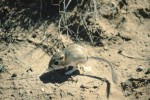
Click On Picture for Larger Image
Species: Dipodomys merriami
Merriam's Kangaroo Rats
Author: Ray Bowers
 Click On Picture for Larger Image |
Species: Dipodomys merriami |
Description:
Merriam's kangaroo rat is a medium sized rodent, but the smallest kangaroo rat, with an average body length of 250mm ( 9.8in) and a tail length of 150mm ( 5.9in ). The body is tan to cinnamon on the back and white on the belly area, with a long tail that is tan on top with a white stripe on the side and a tuft of long hair at the end. The back legs are enlarged, 40mm (1.5in ), and the ears are small, 14mm ( 0.5in ). The average weight is 44g ( 1.6oz ).
Geographic range:
Southeastern California and Western Nevada across southern Arizona and New Mexico to western Texas and south into Mexico.
Habitat:
Merriam's kangaroo rat is found in sandy to rocky soils in desert open shrub lands and grasslands, especially with mesquite.
Food Web:
Merriam's kangaroo rat primarily feeds on seeds, but it will eat green plant as well as insects. They have a good sense of smell and can locate seeds that are buried underground. Seeds that are found are carried in cheek pouches back the their burrow to be eaten or stored. Merriam's kangaroo rat can get most if not all of their water needs met from the food they eat. They are preyed upon by a variety of nocturnal predators.
Reproduction and Development:
Breeding occurs from February to October, but there seems to be some evidence that the peak of mating is reached when the animals are eating fresh green vegetation. Young are born from twenty-six to thirty days after mating. There are usually three young per litter, but there may be from one to six. In warmer areas there may be two litters per year. The young are born with their eyes closed and hairless. The young remain in the burrow until they are about adult size, which is one or two months after birth. Some kangaroo rats have lived to three years of age in captivity.
Behavior:
Breeding occurs from February to October, but there seems to be some evidence that the peak of mating is reached when the animals are eating fresh green vegetation. Young are born from twenty-six to thirty days after mating. There are usually three young per litter, but there may be from one to six. In warmer areas there may be two litters per year. The young are born with their eyes closed and hairless. The young remain in the burrow until they are about adult size, which is one or two months after birth. Some kangaroo rats have lived to three years of age in captivity.
Ecosystem roles:
Merriam's kangaroo rats are primarily nocturnal seed harvesters, and are fed upon by predators such as owls and foxes. If Ord's kangaroo rat is present it is usually found in the sandy areas, and the Merriam's is found in the areas with rocky soil. Other animals, such as reptiles or tarantulas may use the abandoned burrows. The burrows may also help in the aeration of the soil, and the infiltration of water.
Other info:
These small kangaroo rats can become quite tame. If a rodent study involves live trapping over a number of days, a rat will learn to come to a trap for food and may be reluctant to leave when released.
Taxonomy:
Kingdom: Animalia
Phylum: Chordata
Subphylum: Vertebrata
Class: Mammalia
Order: Rodentia
Family: Heteromyidae
Genus: Dipodomys
Species: Dipodomys merriami
References:
Burt, William Henry; and Richard Philip Grossenheider. 1976. A Field Guide to the Mammals, 3rd ed. (Peterson Field Guide Series; no. 5). Boston : Houghton Mifflin, 289 p., 47 plates
Cockrum, E. Lendell; and Yar Petryszyn. 1992. Mammals of the Southwestern United States and Northwestern Mexico . Tucson : Treasure Chest Publications, 192 p.
Findley, James S. 1987. The Natural History of New Mexican Mammals. Albuquerque : University of New Mexico Press, 164 p.
Findley, James S.; Arthur H. Harris; Don E. Wilson; and Clyde Jones. 1975. Mammals of New Mexico . Albuquerque : University of New Mexico Press, 360 p.
MacMahon. James A.1985. Deserts. New York : Alfred A Knopf, Inc.